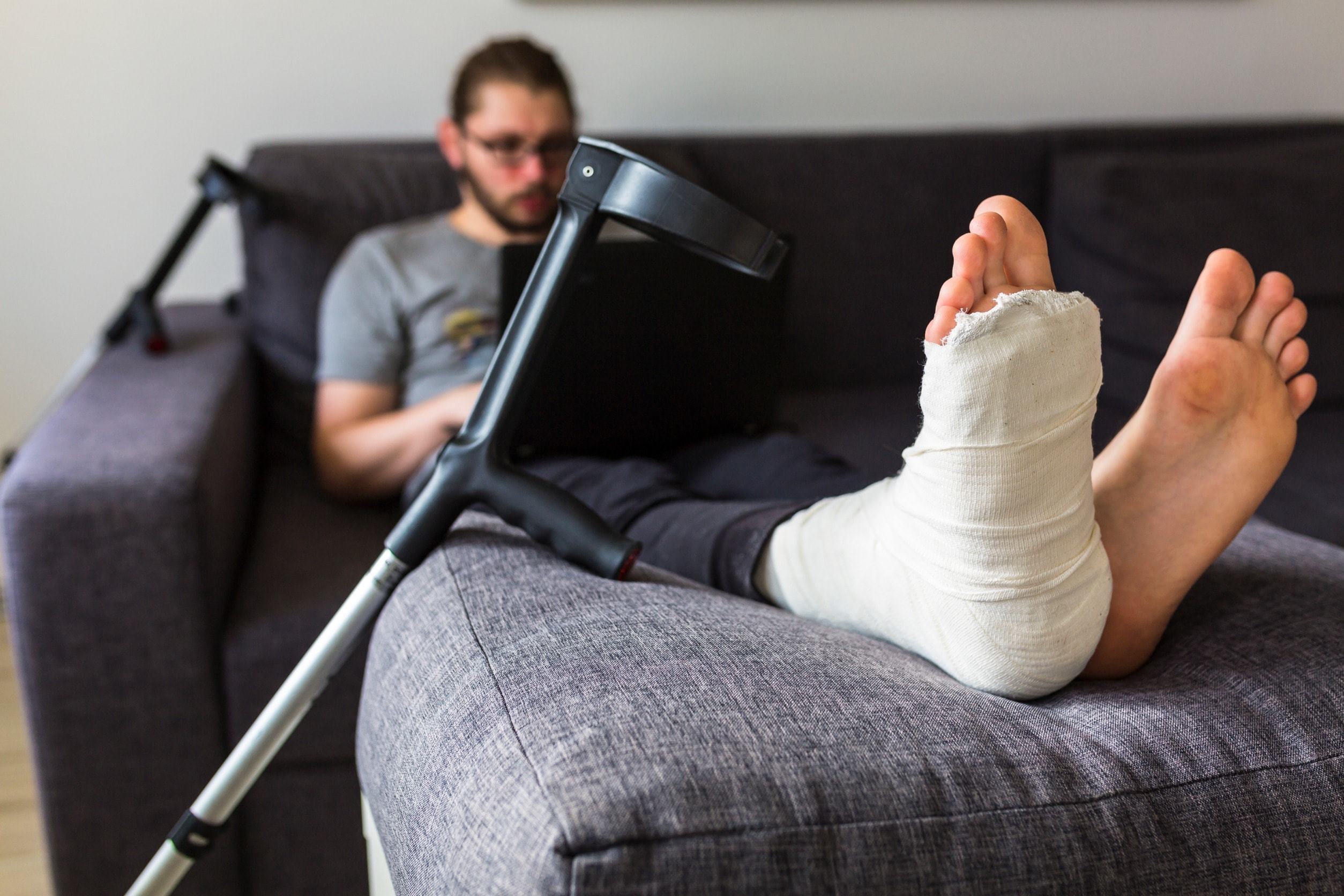You could claim compensation for a broken ankle with the help of No Win No Fee personal injury solicitors. This guide will explain how you could start today.
The first part of this guide will explain who is eligible to make an ankle injury compensation claim and why. Under the law, you can expect certain standards from others when it comes to your safety, and you can claim compensation if they fail to meet those standards and, in the process, cause you to have an injured ankle.
We will then go onto discuss how compensation for a broken ankle and other injuries to the ankle joint could be awarded. This will depend on the nature of your injuries and whether they have cost you financially. You are likely to get different compensation for an ankle fracture, for example, than for a dislocated ankle or torn achilles tendon. For clarity, we will also explore how different injuries can happen.
Finally, we will explore what personal injury lawyers do when they submit ankle injury claims on behalf of their clients and how our panel is able to do so on a No Win No Fee basis. Whether you have an unpleasant ankle sprain or a completely fractured ankle, they are more than ready to do the same for you.
Read this guide or get in touch immediately to get started:
- Call us on 0800 408 7826.
- Use our Contact Us page.
- Use the Live Chat feature below.
Select A Section
- Broken Ankle Compensation Calculator
- Different Types Of Injuries You Can Claim For
- Common Reasons For Broken Ankle Claims
- Making A Claim For Compensation
- How Our Panel Of Solicitors Can Help You Claim For A Broken Ankle
- More Information
Broken Ankle Compensation Calculator
You can seek compensation for a broken ankle with a personal injury claim. This is where you sue the person or party that caused your ankle injury. You claim compensation by showing that this third-party was negligent, where:
- They owed you a duty of care.
- They breached this duty.
- This breach caused your broken ankle or other ankle injury.
A duty of care obliges you to meet a standard of care that is reasonably expected of you, say if you drive a car or control a public space. If you fail to meet that standard, you breach that duty. We will explain this in more detail later in this guide.
If you think you are eligible to make a personal injury claim, you may have sought an estimate of your payout using a compensation calculator. However, the calculator cannot tell you what factors will be considered when looking at how much compensation you could be awarded.
How Payouts Are Calculated
How much compensation you get for an ankle injury claim will depend on two factors. Ankle injury compensation is, therefore, also divided into two types:
- General damages for the pain and suffering experienced as a result of the accident that caused your broken ankle.
- Special damages for expenses that follow from your broken ankle.
General damages are calculated by comparing your medical reports to the Judicial College Guidelines (JCG). These guidelines are designed to allow the parties involved in the personal injury claims process to work with the same figures.
The table below provides some examples of ankle injuries from the Guidelines. Please note that they are based on past ankle injury compensation amounts. They are not a guarantee of ankle injury settlement amounts today. Ankle injury cases vary too much for this to be possible. It should be noted that the figure at the top of the table was not taken from the JCG.
| Injury | Severity | Compensation | Notes |
|---|---|---|---|
| Multiple Injures Plus Special Damages | Very Severe | Up to £500,000 or more | Not a JCG figure. |
| Foot | Amputation of Both Feet | £206,730 to £245,900 | Treated like below-knee amputation due to loss of ankle joint. |
| Amputation of One Foot | £102,470 to £133,810 | See entry for Amputation of Both Feet. | |
| Very Severe | £102,470 to £133,810 | Causing significant pain and/or very serious disability. | |
| Severe | £51,220 to £85,460 | Includes fractures to both feet with substantial increases to pain and immobility. | |
| Serious | £30,500 to £47,840 | Continuing pain and increased risk of arthritis and effusion surgery. | |
| Ankle | Very Severe | £61,090 to £85,070 | Includes serious ankle injuries including transmalleolar ankle fractures and extensive soft tissue damage. |
| Severe | £38,210 to £61,090 | Cases tend to involve extensive recovery periods and a reduced ability to walk. | |
| Moderate | £16,770 to £32,450 | Includes moderate ankle injuries such as ligament tears that cause some but not total disability. | |
| Modest Injuries | Up to £16,770 | Includes ankle sprains and fractures that cause long-term weakness, scarring, or immobility. |
The second part that could make up your compensation amount is based on any financial losses linked to your broken ankle injury. Special damages include:
- Loss of income, past and future, due to a broken ankle injury.
- Medical expenses, including those for private medical treatment or ankle injury rehab.
- Costs of care, travel, domestic help, or accessibility adjustments.
Each part of a broken ankle claim requires evidence. For the cost of fitting a stairlift in your home after having suffered a broken ankle, for example, you would likely need quotes from several suppliers and a doctor’s note confirming that you need it.
You don’t have to make this case alone. A personal injury lawyer from our panel can help you gather this evidence. Speak to our advisors using the details above to get started.
Can I Claim For A Broken Ankle If I Am Partially At Fault?
Yes, you may be able to claim a broken ankle compensation payout even if you are partially at fault. As we discussed in the eligibility section above, in order to claim compensation for a broken ankle, you need to establish the fault of the other party. However, if there is some responsibility from your side, you may still receive a compensation payout, but it will be reduced to reflect the proportion of your fault.
This is possible due to the concept of contributory negligence. This term deals with your responsibility for your injury. On the other hand, split liability refers to your contribution towards the accident which resulted in your injuries. Let’s clarify the difference between the two concepts through an illustrative example:
If you were injured by a speeding vehicle but you weren’t wearing a seatbelt, you contributed to your injury. This is where your compensation will be reduced by 25% if you are found to be 25% responsible.
On the other hand, if you are distracted and talking on the phone while driving and another speeding vehicle approaches. Both of you collide with each other because you failed to check your surroundings before moving forward. Therefore, the liability will be split between the two of you depending on the extent of fault.
However, for the purpose of this guide, we’ll focus only on contributory negligence or a situation where you’re responsible for your injury. Speak to our advisors now to check your chances of getting compensation.
Different Types Of Injuries You Can Claim For
The ankle joint is not a distinct body part in the same way that your upper arm and thigh are. Instead, it is the muscles, joints, and ligaments that connect your lower leg to your foot. Compensation for a broken ankle may therefore cover damage to any of these areas.
Here are a few examples of common broken ankle injuries.
Trimalleolar Ankle Fracture
Trimalleolar ankle fractures affect the three bony protrusions that stick out from the inside, outside, and back of your ankle. Because it leaves nothing intact that can stabilise the ankle while the damaged parts can heal, this is a fairly serious ankle injury that usually requires corrective surgery and extensive physical therapy.
Bimalleolar Ankle Fracture
Bimalleolar ankle fractures affect the bony protrusions on the inside and outside of your ankle. This is a less serious ankle injury than trimalleolar fractures (see above) and can sometimes be treated with a cast. Surgery and physical therapy may still be required due to a lack of stability.
Crushed Ankle Injuries
The bones in your ankles can be damaged by crush injuries. This where a heavy object, say a car or forklift, applies enough pressure to cause broken bones and soft tissue damage.
You can still claim compensation for an ankle injury if you do not see your particular case listed here. Our advisors are available 24/7 to discuss your case via the details at the top of this page.
Common Reasons For Broken Ankle Claims
There are a number of settings in which you might be able to claim compensation for a broken ankle. They all meet the conditions for a personal injury claim, as set out in the section above. This is where someone is harmed by a breach of a duty of care.
In this section, we will consider how an ankle injury claim might arise in the context of a road traffic accident, accident at work, and accident in a public place.
Road Traffic Accidents
Road users have a duty of care to not endanger each other. They breach this duty if they break the rules meant to keep road users safe, i.e. The Road Traffic Act 1988 or Highway Code. For example:
- A driver enters a junction without slowing and does not have time to see you crossing. They hit you at speed, and you are left in a cast for weeks while your knee and ankle bones heal.
- You brake hard when a motorcyclist overtakes you without warning. You experience a sprained ankle, chest bruising, and panic attacks when you drive past where the car accident happened.
If an incident like this happens, you may be able to make a road traffic accident claim.
Accidents At Work
Employers have a duty of care to their staff under the Health and Safety at Work Act, etc 1974. They breach this duty if an employee receives an ankle injury they could have prevented with reasonable steps. This includes reporting non-trivial accidents, conducting risk assessments, having a health and safety policy, and providing proper training and Personal Protective Equipment (PPE).
- Your foreman does not provide you with a harness while you lay roof tiles. You slip on the wet floor, fall over the scaffolding, suffer serious ankle injuries and permanent ankle stiffness.
- Your manager allows an unqualified trainee to operate the forklift. When they leave the brakes off, it rolls down a service ramp and runs you over, leaving you with ligament injuries and ongoing pain.
If an incident like this happens, you may be able to make an injury at work claim.
Accidents In A Public Place
An occupier is someone who controls a public space. They have a duty of care to anyone using that public space for its intended purpose under the Occupiers Liability Act 1957. They breach this duty if a visitor suffers an ankle injury in an incident they could have prevented with reasonable steps.
- You suffer a sprained ankle after tripping on pavement at your local park. The local council was told the pavement was uneven a month previously.
- Your gym fails to have their equipment checked on a regular basis. A machine breaks while you use it, pulling your leg in an unnatural direction and rupturing your achilles tendon.
If an incident like this happens, you may be able to make a public liability claim. Contact our advisors using the details above to get started on your claim for compensation for a broken ankle.
Making A Claim For Compensation
When you instruct personal injury solicitors to claim for ankle injury compensation on your behalf, the first steps of the claims process will usually be to gather evidence and write a Letter of Claim.
A Letter of Claim sets out your broken ankle claim to the party responsible. It describes the nature of your ankle injuries, why they are to blame, how much compensation they owe you, and how the matter should be settled. Evidence-gathering continues while the other side is given time to admit or deny liability for the incident that caused your ankle injuries.
The rest of the compensation claim will generally consist of negotiation. A vast majority of ankle injury cases are settled without any involvement from the Court.
What Evidence Do I Need?
The amount and strength of the evidence you provide may be one of the biggest factors in deciding how much compensation you receive. It will also determine whether you receive compensation for a broken ankle in the first place.
- Witness Contact Details – A legal professional can take a statement from anyone who saw your ankle injury happen.
- Medical Evidence – Having your ankle assessed after a harmful incident means a professional can confirm the cause and prognosis of your ankle injury.
- Accident Reports – Employers must log health and safety incidents if they have ten or more staff and let the Health and Safety Executive know about any reportable injuries. The Health and Safety Executive monitor workplace incidents in Great Britain.
- Receipts and Invoices – This will allow you to claim for financial losses related to your ankle injury.
How Long Can It Take To Get Compensation
The time it takes to claim broken ankle compensation will vary on a case-by-case basis due to the differences between personal injury claims.
Very severe injuries may require more research and evidence than the most common ankle injuries. Delayed or ongoing symptoms can also shift the claims process, as can a prognosis of permanent disability.
Finally, while our panel of personal injury solicitors are highly efficient, they will always prioritise following proper procedure and working towards the best ankle injury compensation possible for you.
Call our advisors today to discuss this further. Their details are at the top of this guide.
How Our Panel Of Solicitors Can Help You Claim For A Broken Ankle
You can make a broken ankle compensation claim with a personal injury solicitor from our panel if you wish to work with:
- Experts with decades of experience getting broken ankle compensation for their clients.
- Considerable resources to gather evidence of your ankle injury and its consequences.
- Compassion and jargon-free legal advice to guide you in the right direction.
You can also do so on a No Win No Fee basis. The type of No Win No Fee service offered is under a Conditional Fee Agreement (CFA). This means that you pay:
- A success fee to your personal injury solicitor if your claim succeeds.
- Nothing whatsoever for your solicitor’s services at the start of your claim or while it is ongoing.
This success fee is also a percentage that is capped by law and agreed beforehand with your legal representative. This means there are no nasty surprises – just peace of mind knowing your ankle injury compensation claim is in good hands.
Just don’t miss out. Under the Limitation Act 1980, you have three years from the date of your injury to make a claim. While there are exceptions, most claims are only valid within those three years.
Contact our advisors today to discuss your eligibility to claim compensation for a broken ankle. If you meet the criteria, you could be connected to one of the personal injury solicitors from our panel:
- Call us on 0800 408 7826.
- Use our Contact Us page.
- Use the Live Chat feature below.
More Information
The following resources will help you progress your reading about how to claim compensation for a broken ankle.
Here are some more guides from us:
- How much compensation for a foot injury?
- How much compensation for a broken tibia and fibula?
- How much compensation for a broken leg?
Here are some useful links from the rest of the internet:
- NHS guidance on how to treat a broken ankle.
- Get financial help if you develop injuries or illness at work.
- Advice from the Government on how to claim Statutory Sick Pay (SSP).
Thank you for reading our guide on how much compensation there can be for a broken ankle.





